Multi-Span Composite Timber Beams with Rational Steel Reinforcements
Abstract
1. Introduction
- Wood material is taken as homogeneous, with average physical and mechanical characteristics.
- Moduli of elasticity in tension and compression are equal.
- Sections that are plane before deformation remain plane after deformation. The deformations of the reinforcing material and the wood are equal and joint.
- Fibers of wood and reinforcing material in sections of the element do not exert pressure on each other and experience linear tension and compression.
- Stresses in the reinforcing material grow in proportion to deformations up to failure.
2. Materials and Methods
- (1)
- series 1—solid wood beams, taken as a standard, with 3 spans of 1.5 m each, with a section of 40 mm × 80 mm (b × h);
- (2)
- series 2—beams reinforced in the lower area of the span and in the upper area of the support with steel bars of A400 class, 8 mm in diameter, with 3 spans of 1.5 m each, with a section of 40 mm × 80 mm (b × h);
- (3)
- series 3—beams reinforced in the lower area of the span and the upper area of the support with reinforcing bars of class A400, 10 mm in diameter, with 3 spans of 1.5 m each, with a section of 40 mm × 80 mm (b × h).
- Revealing of the force-displacement state of multi-span reinforced beams and identification of the nature of the failure of such structures;
- Determination of the magnitude of the failure loads;
- Comparison of the results from experimental and theoretical studies.
- Engineering (theoretical) calculation of beams;
- Numerical calculation in the software package;
- Planning an experimental study;
- Experimental (laboratory) research;
- Cameral processing of the results.
3. Results and Discussion
4. Conclusions
- Fracture of a series of composite beams occurred with the formation of plastic hinges in the form of folds in the compressed zone at average linear loads of 13.68 and 15.61 kN/m for series 2 and 3, respectively. In contrast, the failure of solid wood beams occurred in the stretched zone in the places where the section weakened in the form of knots or cut fibers of the near-knot cross grains with an average linear load of 4.01 kN/m.
- Rational reinforcement of wooden beams increased their bending capacity and reduces deformability by 75% and 85% for series 2 and 3, respectively. When analyzing the test, the required safety factor was k = 1.49…1.55 for a series of solid wood beams and k = 1.91…2.0 for a series of composite beams.
- It was experimentally confirmed that the failure of composite timber beams had a plastic nature and occurred only along normal sections. These results eliminated the possibility of brittle fracture from tangential stresses and ensured the operational reliability of structures.
Author Contributions
Funding
Institutional Review Board Statement
Informed Consent Statement
Data Availability Statement
Conflicts of Interest
References
- Nowak, T.; Jasieńko, J.; Kotwica, E.; Krzosek, S. Strength enhancement of timber beams using steel plates—Review and experimental tests. Drewno 2016, 59, 75–90. [Google Scholar] [CrossRef]
- Walkup, S.L.; Erceg, M.; Brown, N.; Brown, V.L. Repair of partially embedded metal connector plates. For. Prod. J. 2016, 66, 225–232. [Google Scholar] [CrossRef]
- Liu, W. Research on product design method of recycling waste building wood. E3S Web Conf. 2020, 179, 01010. [Google Scholar] [CrossRef]
- Ribeiro, A.S.; de Jesus, A.M.P.; Lima, A.M.; Lousada, J.L.C. Study of strengthening solutions for glued-laminated wood beams of maritime pine wood. Constr. Build. Mater. 2009, 23, 2738–2745. [Google Scholar] [CrossRef]
- Barteneva, E.A.; Ylesin, M.A.; Mashin, N.A.; Dubrov, D.V. Improvement of heat-insulating properties of foam concrete by means of mineral additives. Key Eng. Mater. 2018, 771, 31–36. [Google Scholar] [CrossRef]
- Krutasov, B.V.; Ylesin, M.A.; Mashin, N.A.; Dubrov, D.V. Hydrophobic modifiers for restoration of old wooden buildings in Western Siberia. Key Eng. Mater. 2018, 771, 43–48. [Google Scholar] [CrossRef]
- Elesin, M.; Mashkin, N.; Bartenjeva, E.; Larichkin, V.; Nikolaeva, M. Studies of heat insulation concrete. Mater. Sci. Forum 2020, 992, 130–134. [Google Scholar] [CrossRef]
- Zhao, Q.Q.; Chen, M.Y.; He, R.L.; Zhang, Z.F.; Ashraf, M.A. Review on antibacterial characteristics of bridge engineering biomaterials. Saudi J. Biol. Sci. 2016, 23, S137–S141. [Google Scholar] [CrossRef][Green Version]
- Roschina, S.I.; Lisyatnikov, M.S.; Melekhov, V.I.; Labudin, B.V.; Lukin, M.V. Application of high glued wooden beams in the ceiling of buildings textile plants. Izvestiya Vysshikh Uchebnykh Zavedenii Seriya Teknologiya Tekstilnoi Promyshlennosti 2016, 5, 267–271. [Google Scholar]
- Roshchina, S.; Lukin, M.; Lisyatnikov, M.; Koscheev, A. The phenomenon for the wood creep in the reinforced glued wooden structures. MATEC Web Conf. 2018, 245, 03020. [Google Scholar] [CrossRef]
- Kuzman, M.K.; Grošelj, P. Wood as a construction material: Comparison of different construction types for residential building using the analytic hierarchy process. Wood Res. 2012, 57, 591–600. [Google Scholar]
- Sobczak-Piastka, J.; Gomon, S.S.; Polishchuk, M.; Homon, S.; Gomon, P.; Karavan, V. Deformability of glued laminated beams with combined reinforcement. Buildings 2020, 10, 92. [Google Scholar] [CrossRef]
- Romano, N.; Lignola, G.P.; Brigante, M.; Bosso, L.; Chirico, G.B. Residual life and degradation assessment of wood elements used in soil bioengineering structures for slope protection. Ecol. Eng. 2016, 90, 498–509. [Google Scholar] [CrossRef]
- Ramage, M.H.; Burridge, H.; Busse-Wicher, M.; Fereday, G.; Reynolds, T.; Shah, D.U.; Wu, G.; Yu, L.; Fleming, P.; Densley-Tingley, D.; et al. The wood from the trees: The use of timber in construction. Renew. Sust. Energ. Rev. 2017, 68, 333–335. [Google Scholar] [CrossRef]
- Loss, C.; Tannert, T.; Tesfamariam, S. State-of-the-art review of displacement-based seismic design of timber buildings. Constr. Build. Mater. 2018, 191, 481–497. [Google Scholar] [CrossRef]
- Aseeva, R.; Serkov, B.; Sivenkov, A. Fire Behavior and Fire Protection in Timber Buildings; Springer: Berlin/Heidelberg, Germany, 2014. [Google Scholar]
- Luo, L.; Shi, B.; Liu, W.; Yang, H.; Ling, Z. Experimental investigation on the fire resistance of glued-in rod timber joints with heat resistant modified epoxy resin. Materials 2020, 13, 2731. [Google Scholar] [CrossRef]
- Ghanbari-Ghazijahani, T.; Russo, T.; Valipour, H.R. Lightweight timber I-beams reinforced by composite materials. Compos. Struct. 2020, 233, 111579. [Google Scholar] [CrossRef]
- Alinoori, F.; Moshiri, F.; Sharafi, P.; Samali, B. Reinforcement methods for compression perpendicular to grain in top/bottom plates of light timber frames. Constr. Build. Mater. 2020, 231, 116377. [Google Scholar] [CrossRef]
- Papavasileiou, G.S.; Pnevmatikos, N.G. Optimized design of steel buildings against earthquake and progressive collapse using cables. Int. J. Progress. Sci. Technol. 2017, 6, 213–220. [Google Scholar]
- Negrao, J.H.J.O. Preliminary study on wire prestressing methods for timber pieces reinforcement. Constr. Build. Mater. 2014, 102, 1093–1100. [Google Scholar] [CrossRef]
- Pnevmatikos, N.G.; Papagiannopoulos, G.A.; Papavasileiou, G.S. Fragility curves for mixed concrete/steel frames subjected to seismic excitation. Soil Dyn. Earthq. Eng. 2019, 116, 709–713. [Google Scholar] [CrossRef]
- Bashandy, A.A.; El-Habashi, A.E.; Dewedar, A.K. Repair and strengthening of timber cantilever beams. Wood Mater. Sci. Eng. 2018, 13, 241–253. [Google Scholar] [CrossRef]
- Jankowski, L.J.; Jasieńko, J.; Nowak, T.P. Experimental assessment of CFRP reinforced wooden beams by 4-point bending tests and photoelastic coating technique. Mater. Struct. 2010, 43, 141. [Google Scholar] [CrossRef]
- Custódio, J.; Broughton, J.; Cruz, H. A review of factors influencing the durability of structural bonded timber joints. Int. J. Adhes. Adhes. 2009, 29, 173–185. [Google Scholar] [CrossRef]
- Issa, C.A.; Kmeid, Z. Advanced wood engineering: Glulam beams. Constr. Build. Mater. 2005, 19, 99–106. [Google Scholar] [CrossRef]
- Nardone, F.; Lignola, G.P.; Prota, A.; Manfredi, G.; Nanni, A. Modeling of flexural behavior of RC beams strengthened with mechanically fastened FRP strips. Compos. Struct. 2011, 93, 1973–1985. [Google Scholar] [CrossRef]
- Vallée, T.; Tannert, T.; Fecht, S. Adhesively bonded connections in the context of timber engineering—A review. J. Adhes. 2017, 93, 257–287. [Google Scholar] [CrossRef]
- Broughton, J.G.; Hutchinson, A.R. Pull-out behaviour of steel rods bonded into timber. Mat. Struct. 2001, 34, 100. [Google Scholar] [CrossRef]
- Martín-Gutiérrez, E.; Estévez-Cimadevila, J.; Otero-Chans, D. Durability of joints made with threaded steel rods glued in chestnut timber—An experimental approach. Compos. Part B Eng. 2017, 108, 413–419. [Google Scholar] [CrossRef]
- Alam, P.; Ansell, M.; Smedley, D. Effects of reinforcement geometry on strength and stiffness in adhesively bonded steel-timber flexural beams. Buildings 2012, 2, 231–244. [Google Scholar] [CrossRef]
- Jasieńko, J.; Nowak, T.P. Solid timber beams strengthened with steel plates—Experimental studies. Constr. Build. Mater. 2014, 63, 81–88. [Google Scholar] [CrossRef]
- Borri, A.; Corradi, M. Strengthening of timber beams with high strength steel cords. Compos. Part B Eng. 2011, 42, 1480–1491. [Google Scholar]
- Koscheev, A.A.; Lukin, M.V.; Roshchina, S.I. Investigation of glued in bars strength and deformability indexes within framework of research of wood reinforcement with cable reinforcement. IOP Conf. Ser. Mater. Sci. Eng. 2019, 687, 033023. [Google Scholar] [CrossRef]
- De Lima, L.C.C.; Costa, A.A.; Rodrigues, C.F. On the use of prestress for structural strengthening of timber beams: Assessment with numerical support and experimental validation. Int. J. Arch. Heritage 2018, 12, 710–725. [Google Scholar] [CrossRef]
- De Luca, V.; Marano, C. Prestressed glulam timbers reinforced with steel bars. Constr. Build. Mater. 2012, 30, 206–217. [Google Scholar] [CrossRef]
- Miebach, F. Design ideas for solid timber bridges. Wood Mater. Sci. Eng. 2018, 13, 184–189. [Google Scholar] [CrossRef]
- Corradi, M.; Osofero, A.I.; Borri, A. Repair and reinforcement of historic timber structures with stainless steel—A review. Metals 2019, 9, 106. [Google Scholar] [CrossRef]
- Wu, W.; Gou, H. Analyzing of the timber beams of ancient buildings strengthened with NSM stainless steel bars. Int. J. Sci. 2015, 2, 77–87. [Google Scholar]
- Metelli, G.; Preti, M.; Giuriani, E. On the delamination phenomenon in the repair of timber beams with steel plates. Constr. Build. Mater. 2016, 102, 1018–1028. [Google Scholar]
- Ghanbari-Ghazijahani, T.; Jiao, H.; Holloway, D. Composite timber beams strengthened by steel and CFRP. J. Compos. Constr. 2017, 21, 04016059. [Google Scholar] [CrossRef]
- Li, A.; Zhou, K.; Wang, C.; Xie, L. Prospective analyses on restoration and reinforcement techniques toward wooden structure of Chinese ancient architectures. J. Southeast Univ. Nat. Sci. Ed. 2019, 49, 195–206. [Google Scholar] [CrossRef]
- Al Ali, M.; Bajzecerova, V.; Kvocak, V. Design methods of timber-concrete composite ceiling structure. Mag. Civ. Eng. 2017, 5, 112. [Google Scholar] [CrossRef]
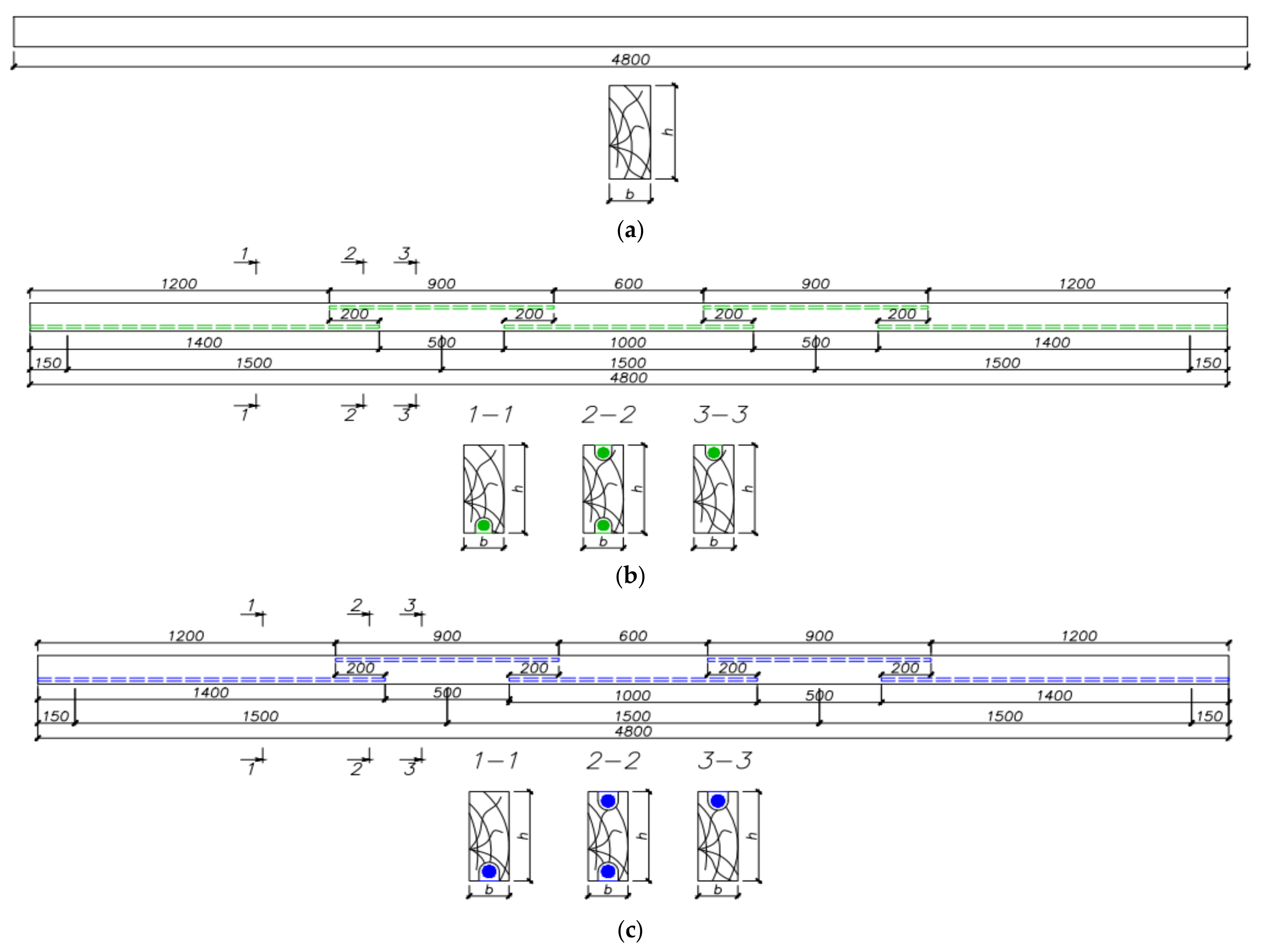
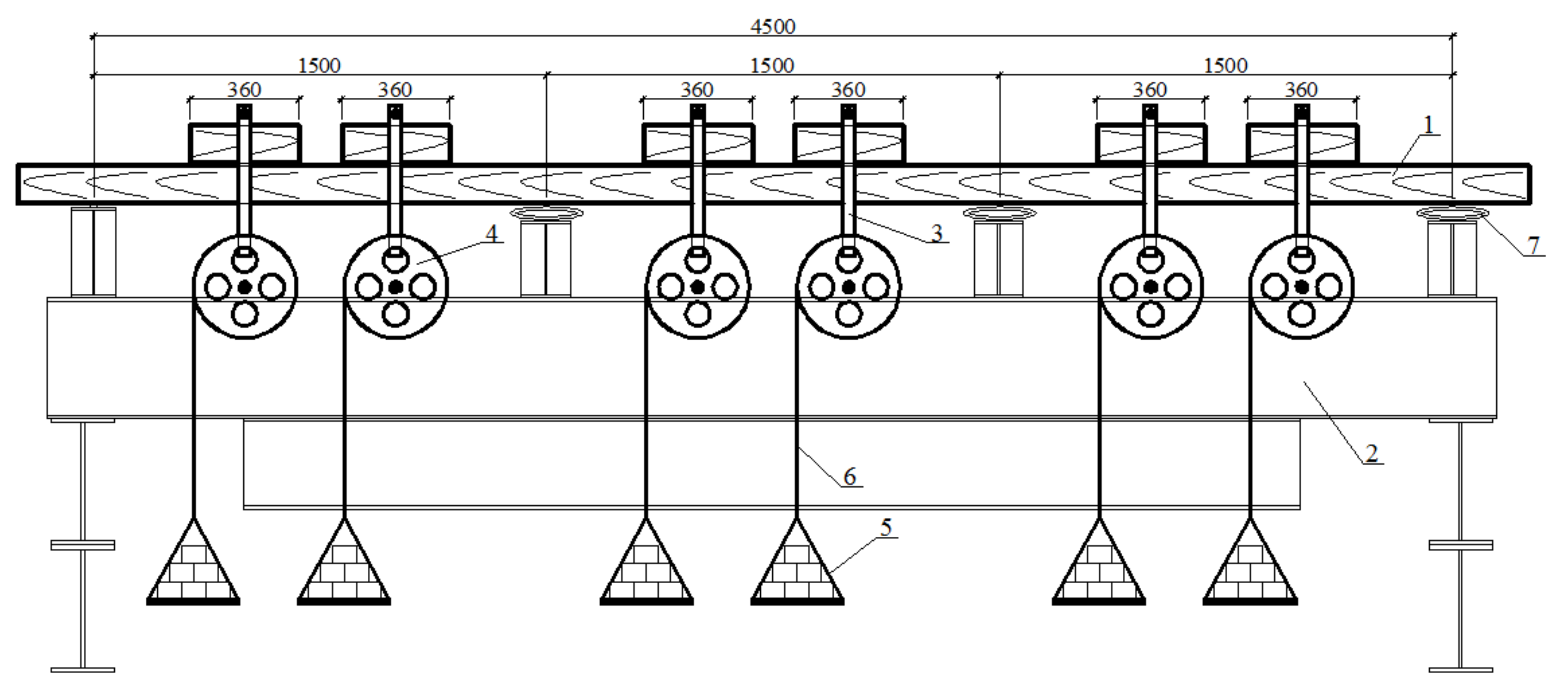
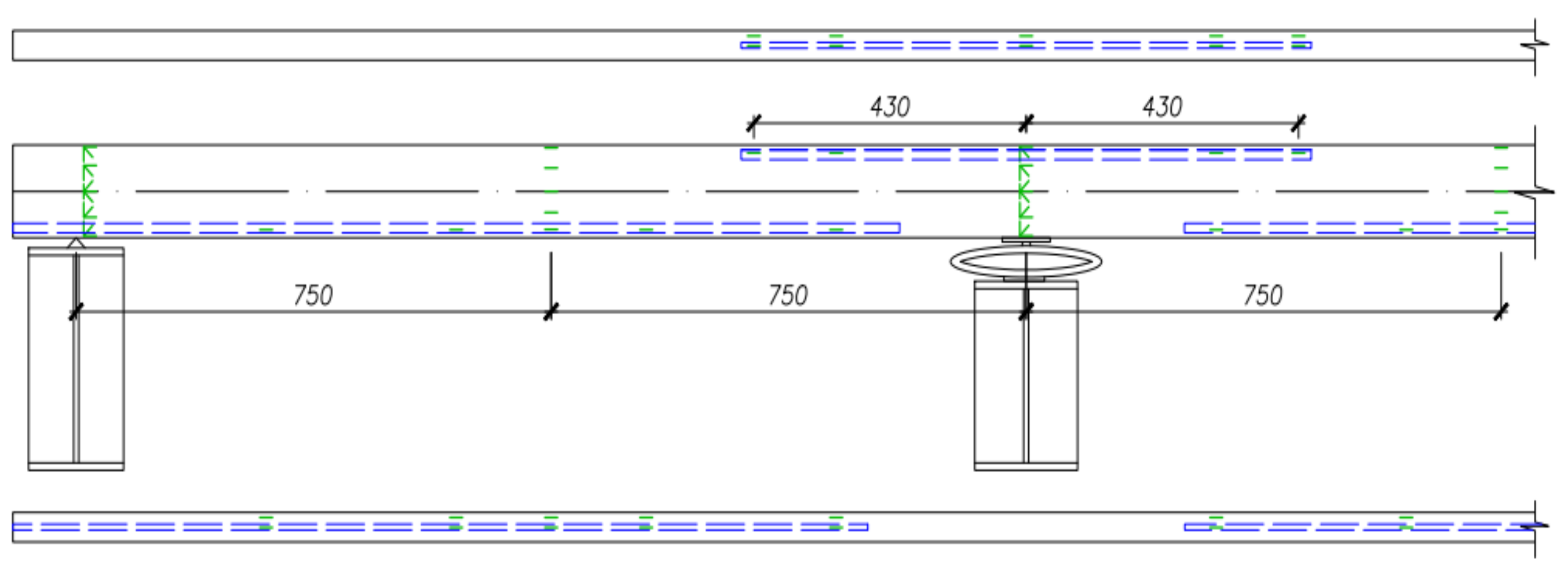
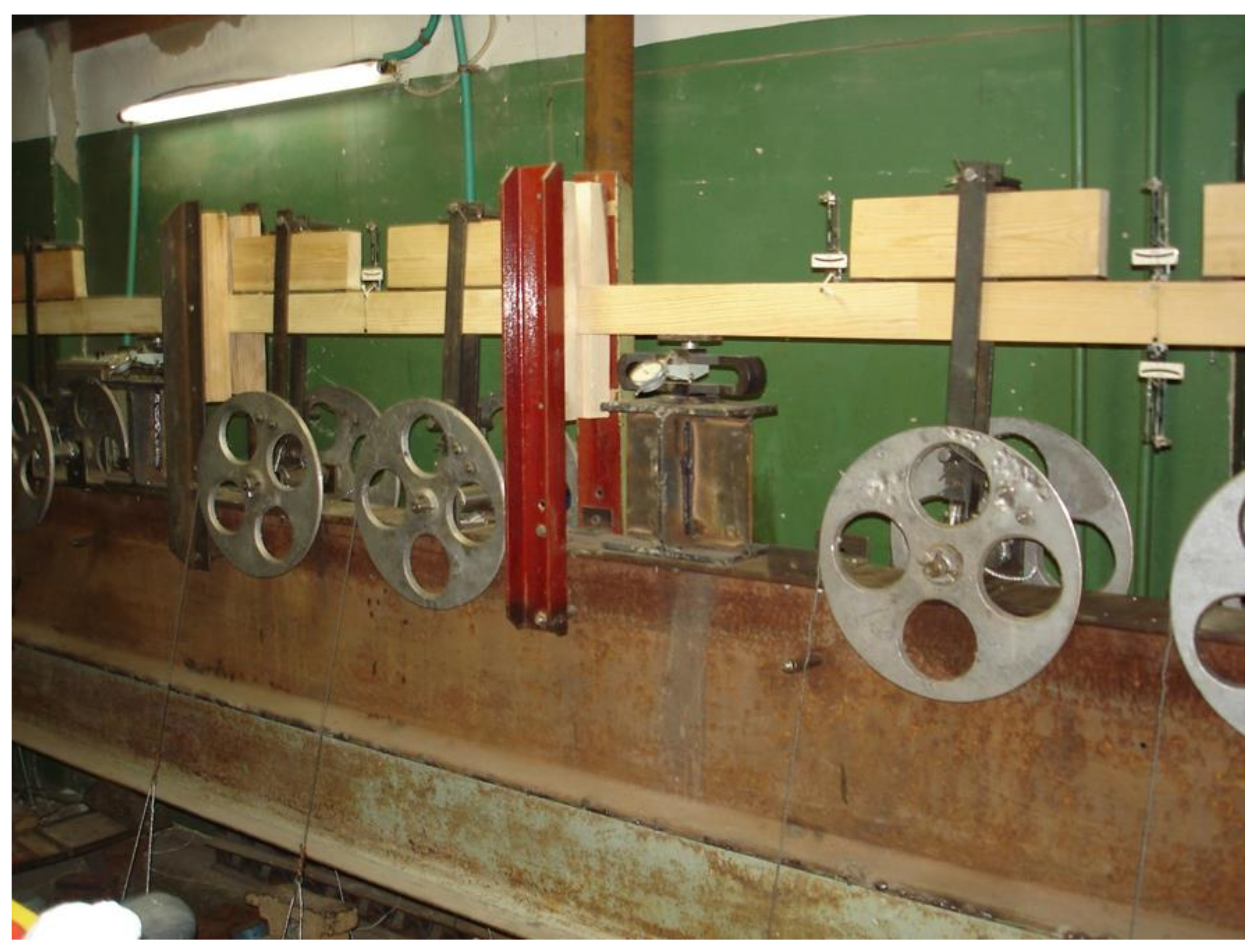
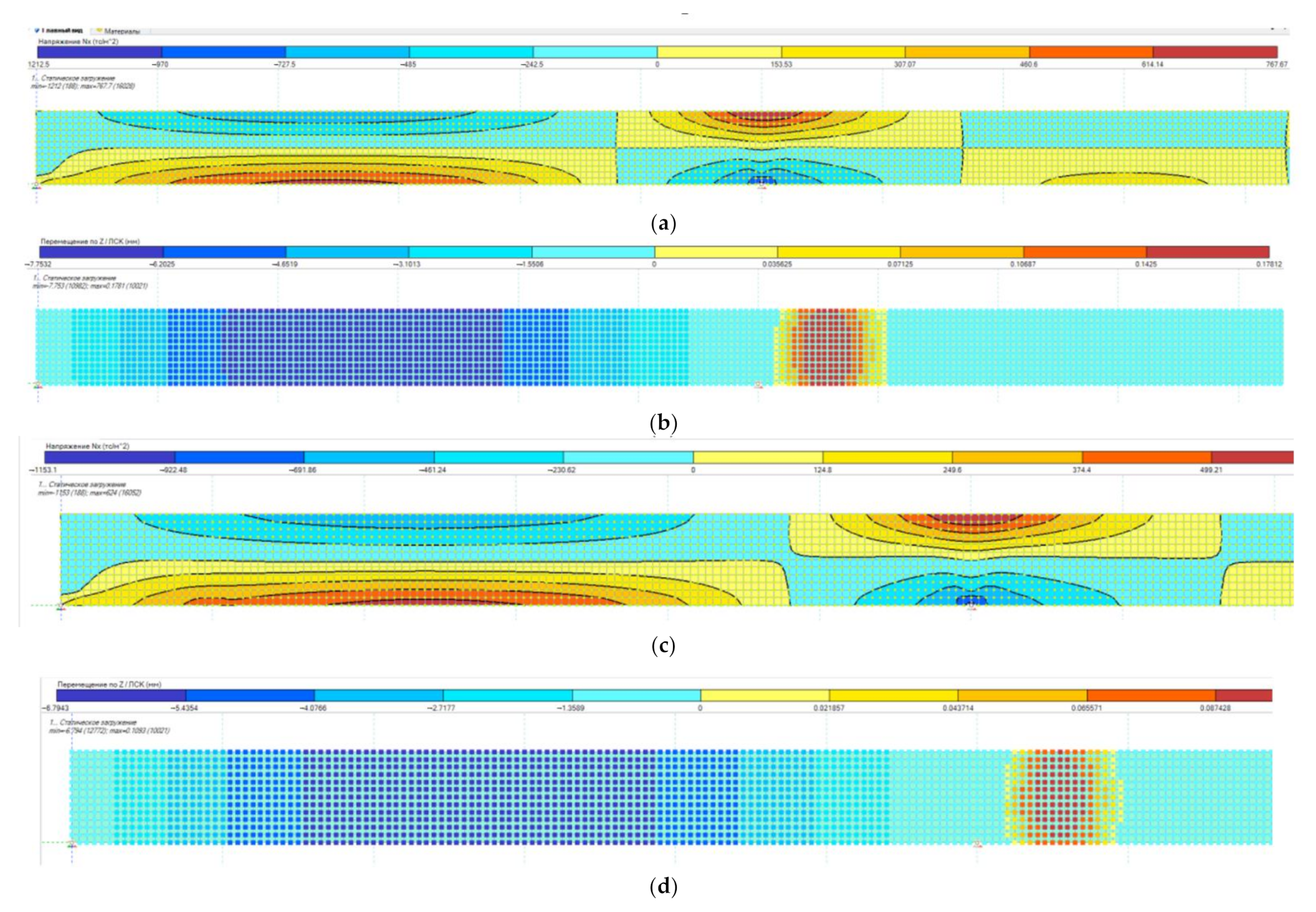
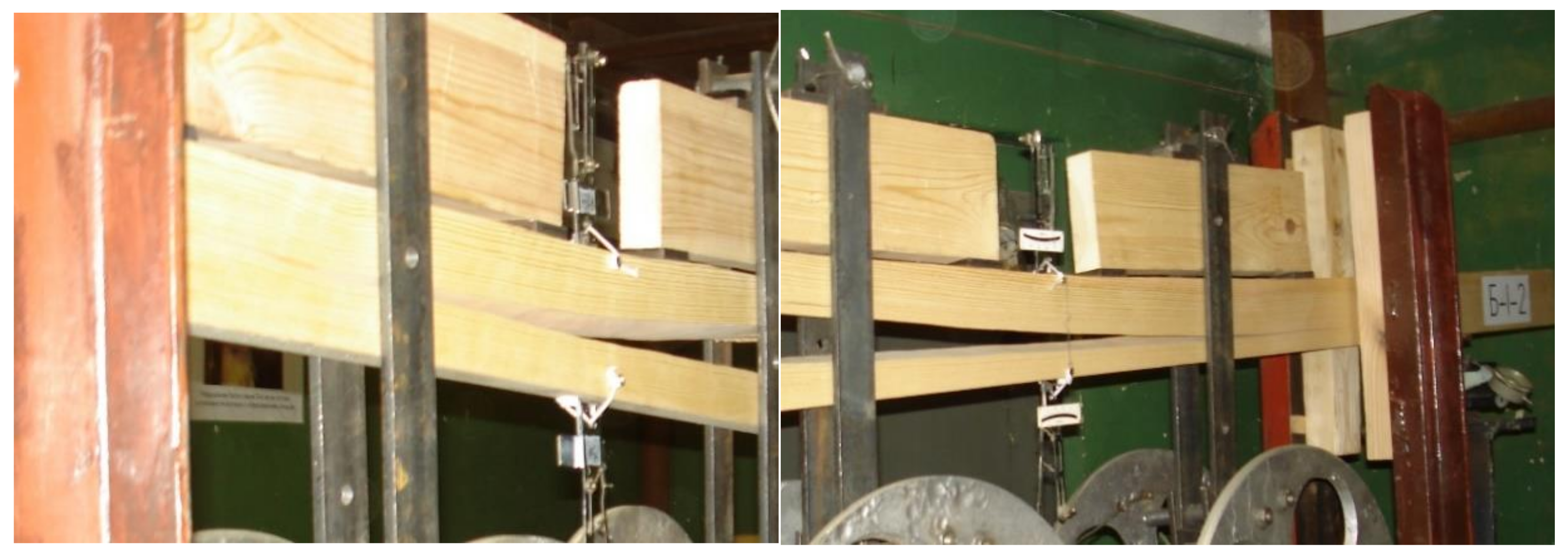
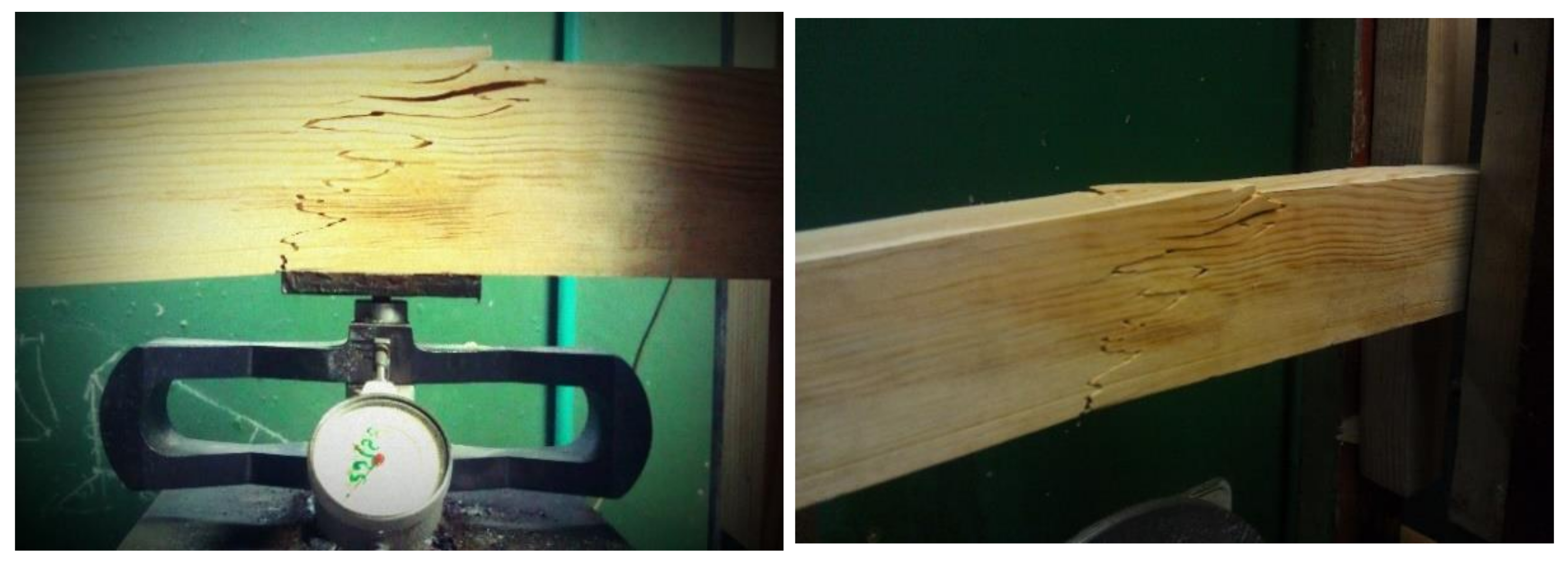
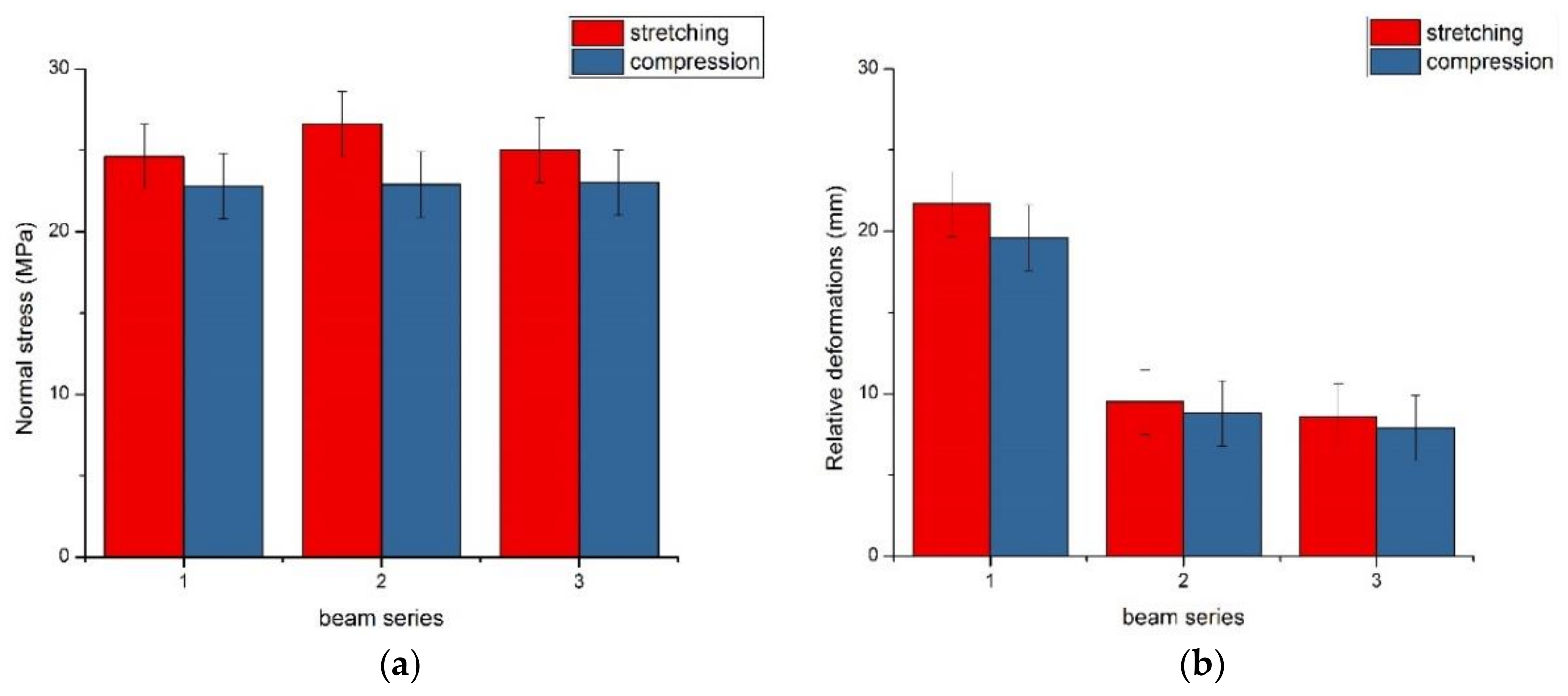
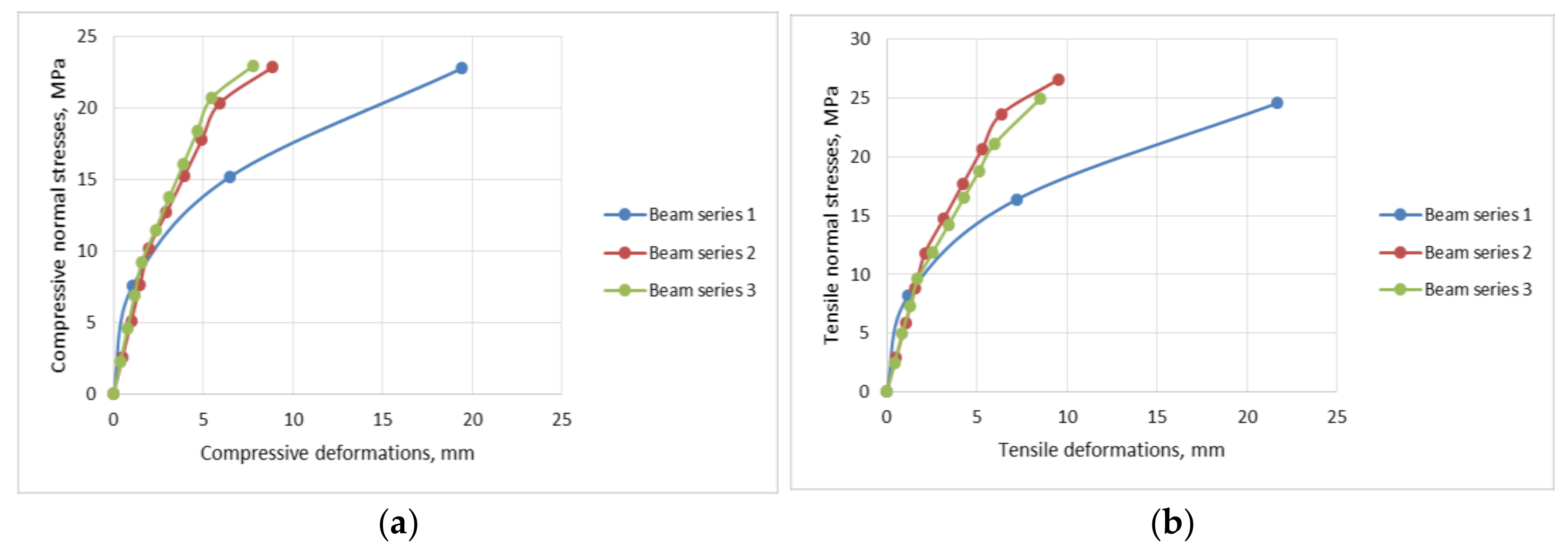
| Beam Series | Section | Design Load p, kN/m | Deformations, ε × 10−4 | Failure Load, kN/m | Safety Factor | Modulus of Elasticity, MPa | Shear Modulus, MPa | ||
|---|---|---|---|---|---|---|---|---|---|
| h, mm | b, mm | Timber | |||||||
| Compressed | Stretched | ||||||||
| 1/1 | 79.0 | 40.0 | 2.6 | 19.42 | 21.70 | 4.10 | 1.57 | 13,255 | 576.3 |
| 1/2 | 80.0 | 39.0 | −”− | 19.48 | 21.70 | 3.89 | 1.49 | 12,868 | 559.5 |
| 1/3 | 80.0 | 39.5 | −”− | 19.52 | 21.68 | 4.05 | 1.55 | 12,735 | 553.7 |
| 2/1 | 81.0 | 40.0 | 6.9 | 8.87 | 9.52 | 13.85 | 2.00 | 12,237 | 532.0 |
| 2/2 | 81.0 | 39.0 | −”− | 8.89 | 9.55 | 13.96 | 2.02 | 13,035 | 566.7 |
| 2/3 | 79.0 | 40.0 | −”− | 8.85 | 9.49 | 13.24 | 1.91 | 12,438 | 540.8 |
| 3/1 | 80.0 | 41.0 | 7.9 | 7.79 | 8.54 | 15.64 | 1.97 | 12,774 | 555.4 |
| 3/2 | 79.0 | 39.0 | −”− | 7.90 | 8.59 | 15.32 | 1.93 | 12,894 | 560.6 |
| 3/3 | 80.0 | 40.0 | −”− | 7.87 | 8.65 | 15.87 | 2.00 | 13,002 | 565.3 |
Publisher’s Note: MDPI stays neutral with regard to jurisdictional claims in published maps and institutional affiliations. |
© 2021 by the authors. Licensee MDPI, Basel, Switzerland. This article is an open access article distributed under the terms and conditions of the Creative Commons Attribution (CC BY) license (http://creativecommons.org/licenses/by/4.0/).
Share and Cite
Lukin, M.; Prusov, E.; Roshchina, S.; Karelina, M.; Vatin, N. Multi-Span Composite Timber Beams with Rational Steel Reinforcements. Buildings 2021, 11, 46. https://doi.org/10.3390/buildings11020046
Lukin M, Prusov E, Roshchina S, Karelina M, Vatin N. Multi-Span Composite Timber Beams with Rational Steel Reinforcements. Buildings. 2021; 11(2):46. https://doi.org/10.3390/buildings11020046
Chicago/Turabian StyleLukin, Mikhail, Evgeny Prusov, Svetlana Roshchina, Maria Karelina, and Nikolay Vatin. 2021. "Multi-Span Composite Timber Beams with Rational Steel Reinforcements" Buildings 11, no. 2: 46. https://doi.org/10.3390/buildings11020046
APA StyleLukin, M., Prusov, E., Roshchina, S., Karelina, M., & Vatin, N. (2021). Multi-Span Composite Timber Beams with Rational Steel Reinforcements. Buildings, 11(2), 46. https://doi.org/10.3390/buildings11020046







